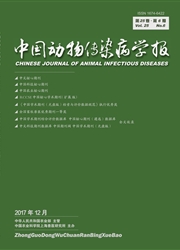

 中文摘要:
中文摘要:
本文以猪流行性腹泻病毒(Porcine epidemic diarrhea virus,PEDV)流行毒株FJzz1/2011株的S1蛋白的切割位点设计合成特异性引物,通过RT-PCR扩增获得S1基因,将其克隆至转移载体p Fast Bac HTA中,获得了重组质粒p Fast Bac HTA-S1,将该重组质粒转化E.coli DH10Bac感受态细胞,得到重组穿梭质粒r Bacmid-S1,再将重组穿梭质粒r Bacmid-S1转染Sf9细胞,48 h后即可观察到明显的细胞病变。将收获的r Bac-S1-P1代病毒在Sf9细胞上连续传3代后,收获细胞培养物,分别用间接免疫荧光鉴定(indirect immunofluorescence assay,IFA)、SDS-PAGE电泳和Western blot分析。结果显示,P3代重组病毒r Bac-S1感染的细胞均呈现亮绿色荧光,证实表达产物可以被PEDV阳性血清和抗S1蛋白的单抗特异性识别;SDS-PAGE电泳结果显示在大约120 k Da左右可观察到特异性条带;Western blot结果证实该蛋白可以被抗S1蛋白的特异性单抗识别。综上研究结果,证明利用杆状病毒表达系统在Sf9细胞中成功表达了PEDV的S1蛋白,为进一步研究PEDV S蛋白的抗原性奠定了基础。
 英文摘要:
英文摘要:
In the present study, we first designed primers based on the cleavage site of S 1/S2 of Porcine epidemic diarrhea virus. The S I gene of PEDV was amplified in RT-PCR and cloned into pFastBacHTA vector and the resulting recombinant plasmid pFastBacHTA-S 1 was transformed into E.coli DH 10Bac competent cells to get the recombinant shuttle plasmid rBacmid-S 1. The transfected cells developed visible cytopathic effect (CPE) at 48 h post transfection (hpt). The recombinant virus (P1) was serially passaged to P3 in the Sf9 cells. The cells were collected and examined in indirect immunofluorescence assay(IFA), SDS-PAGE and Westem blot. The Sf9 cells infected with recombinant virus rBac-S1-P3 showed bright green fluorescence when stained with PEDV pig antisera and monoclonal antibody (McAb) against PEDV S 1 protein. The SDS-PAGE analysis showed a band at around 120 kDa corresponding to the molecular weight of candidate recombinant protein. This protein band was also visualized in Westem blot using McAb against S 1 protein. All these results showed that the S 1 protein of PEDV strain FJzz 1/2011 was expressed in the Sf9 cells using baculovirus expression system.
 同期刊论文项目
同期刊论文项目
 同项目期刊论文
同项目期刊论文
 期刊信息
期刊信息
